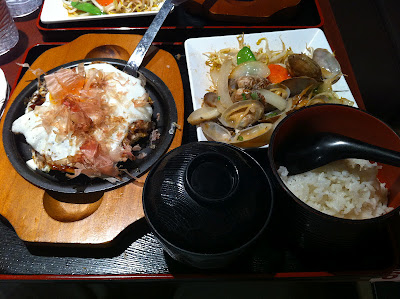Tampopo Restaurant is one of my favourite restaurant when it comes satisfying my ramen craving. It has been around for sometime, starting off with an outlet in Liang Court. Today, it is a restaurant chain serving Japanese Cuisine and has expanded to Takashimaya and also opened the Tampopo Deli at the basement of Liang Court. Tampopo is popular for its black pig ramen and first started in Liang Court.
We arrived at the restaurant at 1130am on a weekday. We were their first customer that day. Before long, the 2nd and third group of customers arrived. We were able to place our orders fairly quickly as we knew what to order before hand. We were served the green tea and the ramen without much delay.
 |
| Original Kyushu Ramen $13.50 |
 |
| Original Kyushu Ramen $13.50 |
The partner ordered the Original Kyushu Ramen. Besides the Kyushu ramen which was thin and hard, the bowl of ramen was served with tamago, black fungus, fish roe, soy sauce pork slice (char siew) and spring onions The Char Siew with a decent fat to lean meat ratio provided a melt in the mouth sensation.
The pork broth which required two days to made was made from pork bone! The pork broth was light, milky and tasty. I felt that it was a tad too salty. Nevertheless, it was still one of the better Japanese ramen around and at $13.50, it was value for money!
The pork broth which required two days to made was made from pork bone! The pork broth was light, milky and tasty. I felt that it was a tad too salty. Nevertheless, it was still one of the better Japanese ramen around and at $13.50, it was value for money!
 |
| Deluxe Tampopo Black Pig Shabu Ramen $16.30 |
 |
| Deluxe Tampopo Black Pig Shabu Ramen $16.30 |
I ordered the Deluxe Tampopo Black Pig Shabu Ramen which was served with tampopo, corns, bamboo shoots, slices of black pig and lettuce. It was topped with lots of chilli flakes and some spring onions. The flavour of the chilli flakes did not overwhelm the taste of the pork bone broth. The broth was tasty yet forgiving. Compared to the broth from the Original Kyushu Ramen, I thought that this was more flavourful. The ramen was well cooked, retained its springiness and was not hard. It was a joy slurping the ramen along with the broth.
As the name black pig shabu suggests, the black pig was sliced thinly (paper thin) with little or no marination so that one can taste the original taste of the meat. Each piece had the right balance of fats and meat and was so soft and tender that they provided a melt in the mouth sensation. If only they gave more slices of the black pig shabu. Oishii!!! Black Pig aka Berkshire Pig is the oldest breed of pig known originating from Reading-Berkshire in England. It is the highest prized pork in Japan and regarded as the best quality of pork in the world.
The Tamago (Japanese half boiled egg) was excellent. A firm and nice consistent dark brown colour on the outside. On the inside, it was soft and the egg yolk was runny - just the way a Tamago should be like. If you are keen to make your very own Tamago, you can click here for the recipe.
As the name black pig shabu suggests, the black pig was sliced thinly (paper thin) with little or no marination so that one can taste the original taste of the meat. Each piece had the right balance of fats and meat and was so soft and tender that they provided a melt in the mouth sensation. If only they gave more slices of the black pig shabu. Oishii!!! Black Pig aka Berkshire Pig is the oldest breed of pig known originating from Reading-Berkshire in England. It is the highest prized pork in Japan and regarded as the best quality of pork in the world.
The Tamago (Japanese half boiled egg) was excellent. A firm and nice consistent dark brown colour on the outside. On the inside, it was soft and the egg yolk was runny - just the way a Tamago should be like. If you are keen to make your very own Tamago, you can click here for the recipe.
Overall, I felt that Tampopo's ramen was as good as Santouka's! Besides the dishes mentioned in this post, the Tonkatsu Ramen, Scoop Cake and Matcha Chiffon Cake are worth a try too. Service wise, the staff were prompt in refilling the green tea and the food got served pretty fast. To be fair, I should add that as we arrived at 1130am on a weekday, there was virtually no crowd in the restaurant.
Tampopo Restaurant (Liang Court)
177 River Valley Road
#01-23/24 Liang Court
Tel: 6338 3186
Opening Hours: Mon to Sat 1130am - 1030pm (last order 10pm)
Sunday and Public Holidays 11am - 1030pm (last order 10pm)
Tampopo Restaurant (Takashimaya)
B2-33 Takashimaya Shopping Centre
Tel: 6235 2318
Opening Hours: Daily 11am to 10pm




























.JPG2896)



















